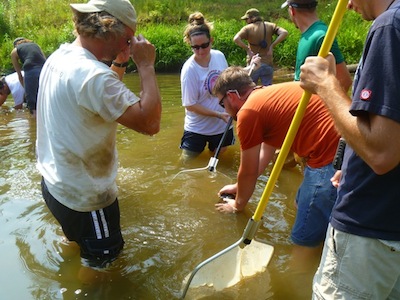
The Eastern Hellbender is a salamander of many names:
“The snot otter’s probably my favorite. Waterdogs is what a lot of people call them in the area. Allegheny Alligator is another one, I’ve heard that one as well,” says Eric Chapman. Chapman works with the Western Pennsylvania Conservancy, the PPG Aquarium, and Purdue University to study eastern hellbender salamanders in Indiana, Pennsylvania. Hellbenders live in large streams and rivers. Chapman and his team have been conducting hellbender surveys in the Little Mahoning Creek Watershed since 2007.
On this blistering hot morning, Chapman and about a dozen other researchers are up to their knees in the water. They heave huge rocks off the creek bed and plunge their hands underneath to feel for salamanders.
Even though they’re the biggest salamander found in the United States, hellbenders are hard to get a hold of—literally. They blend in perfectly with the muddy creekbed, and they’re slippery. Trying to catch a hellbender is like being blindfolded and trying to grab a slime-coated rubber ball, underwater.
As unsavory as that sounds, researchers keep hunting, because these animals are a big help to aquatic scientists. Hellbenders can live up to 50 years in pristine water conditions. But years of environmental damage from things like dams, agriculture, logging and acid mine drainage have cut into the species’ population. The hellbender’s sensitivity to habitat change gives biologists insight into the area’s ecological health. Chapman says they’re still thriving in places like the Little Mahoning Creek.
“The fact that we’ve found any at all is a very good indication of good, stable water quality here.”
Since many locations haven’t been sampled in over 50 years, it’s hard to tell whether or not the hellbenders are in serious danger. Chapman and the Western Pennsylvania Conservancy are hoping to fill in the gaps in the animal’s natural history.
After about half an hour of digging around in the murky water, the researchers finally uncover the right rock. At first glance, the hellbender looks basically like a hunk of rotting wood, a creature worthy of a bad sci-fi film. As it squirms around in the net, a couple of beady eyes on top of its big flat head pop out. Chapman points out that the salamander has a wide gaping mouth to vacuum in crayfish and four stubby legs with grippy toes that help it get around the riverbed. He says hellbenders breathe mainly through folds of skin along the side of their bodies, and ooze mucus as a defense mechanism. “They’re kinda cute in a weird way” laughs Colleen O’Neill.
Eric Chapman counters ,”They’re gorgeous.”
A researcher hefts the net out of the water and carries the hellbender to the shoreline. Damp skin glistening in the sun, the animal doesn’t wriggle or make noise. Chapman picks it up carefully and lays it out it on a long ruler.
“It measures 51.5 centimeters, so about 20.25 inches. Pretty average size hellbender for Little Mahoning Creek. This is an older animal. About a pound and a half in weight."
Then he checks to see if the hellbender has a “pit tag” in it.
“It’s like a microchip that you put into a dog or a cat, like a little hellbender social security number. So that when we do our mark and recapture surveys we can know if this animal’s gained weight or not over time, to try and measure the population in Little Mahoning Creek.”
After the salamander’s tagged and tested he’s released back out into the riverbed.
To make sure scientists can continue to find this hellbender and his slimy friends, Chapman and his team are doing creek restoration work with private landowners and Indiana County. Their funding comes from the state of Pennsylvania.